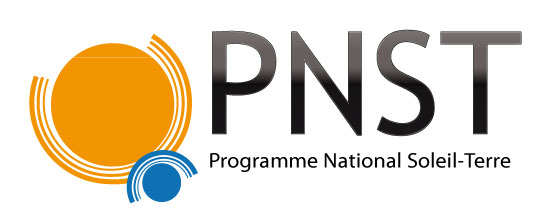Space Weather
1. Space weather activities in France
Space weather is the research field that deals with phenomenological aspects and the physical state of space environments. A variety of objectives are addressed by means of observation, monitoring, data analysis and modelling : to examine and predict the physical state of the Sun, interplanetary space, planetary environments (especially the terrestrial one) as well as the impact of perturbations, be they of solar origin or not ; to analyze in real time and predict possible effects on biological and technological systems.
All research activities dealing with solar-terrestrial relations in France are part of space weather, viz. : physics of the Sun and of the solar wind, physics of the terrestrial magnetosphere and its interaction with the atmosphere. The fundamental research involved in this field aims at investigating plasma processes that can be observed in situ in the heliosphere, but these processes are of general importance in astrophysics. An increasing number of data, methods and results obtained here are of interest for space weather and some of them are actually explicitly developed on this purpose.
More information on these issues can be found on laboratory web pages such as :
On the european side, a well documented website is European Space Weather Portal :
See also :
- http://fr.wikipedia.org/wiki/M%C3%A9t%C3%A9orologie_de_l%27espace
- FEDOME project
- Documentaire "La météo de l'espace, l'émergence d'une nouvelle science" réalisé par Jean-Louis Saporito et co-produit par CNRS Images diffusé sur France 5 le 25 juillet de 19h-20h
- InfoDay H2020 Espace à Toulouse/Paris/Cannes le 9 octobre 2015 : plus d'info
- Le journal du CNRS contient un article grand public sur la météorologie de l'espace, intitulé "Météo solaire, tempêtes et black-out"
- Document de "l'observatoire de l'espace" décrivant le projet "solar wind" de Laurent Grasso.
- Over the past 2+ years LWS Steering Committee and the heliophysics community had embarked on an audacious task for creating a vision for LWS for the next decade. That final report has just now been completed.
- La stratégie américaine en matière de météorologie spatiale : voir document
2. Data centers and space weather services in France :
2.1 From the Sun photosphere until 1 AU :
Sun in visible light :
- Meudon spectroheliograms : http://solaire.obspm.fr/
- disk imaging and coronagraphy at Pic du Midi (CLIMSO) : http://www.climso.fr/
- spectro-polarimetry THEMIS (observation campaigns, regions of interest)
Radiowave observations :
- ground spectrography and imaging at Nançay : ORFEES 1000-130 MHz, NDA 70-20 MHz, NRH in the 150-450 MHz frequency range http://www.obs-nancay.fr/en
- space borne spectrography in the 16 MHz - a few kHz (Earth npe) frequency range : Wind and STEREO spacecraft http://www.lesia.obspm.fr/-WAVES-sur-WIND-.html , http://www.lesia.obspm.fr/STEREO-WAVES.html
High-energy particles in the near-Earth environment :
- Earth's radiation belts (data and models) http://craterre.onecert.fr/home.html
- cosmic rays : data from neutron monitors at Kerguelen and Terre Adélie (http://previ.obspm.fr/; 1 min, real time www.nmdb.eu)
- solar energetic particle events and associated radio, X-ray and gamma-ray : observations server.sepserver.eu
Sun from space :
- solar wind Ly alpha observations http://swan.projet.latmos.ipsl.fr
- Coronal Mass Ejection (CME) catalog SoHO/LASCO http://www.oamp.fr/lasco/
The terrestrial magnetosphere :
- Earth's magnetic field measurements from ground magnetometers http://www.bcmt.fr/
2.2 Data archiving and dissemination :
- CDPP : spacecraft data (solar wind, magnetosphere) : http://www.cdpp.eu/
- MEDOC : spacecraft data (Sun) : https://idoc.ias.u-psud.fr/medoc
- BASS2000 : ground data (Sun) http://bass2000.bagn.obs-mip.fr/, http://bass2000.obspm.fr/
- NMDB : neutron monitor database (cosmic rays) http://www.nmdb.eu
Analysis tools :
Data products and services :
- real time estimate of total and spectral Sun irradiance http://lpc2e.cnrs-orleans.fr/~soteria/
- synthetic visualization of Sun radio observations http://secchirh.obspm.fr/
- magnetic field extrapolation from SOLIS synoptic maps http://www.cpht.polytechnique.fr/cpth/amari/pages/solarmodels/index.html, - http://www.lesia.obspm.fr/solaire/fromage/
- geomagnetic indices http://isgi.cetp.ipsl.fr/
- semi-emprical model of thermospheric temperature, density and composition http://www.atmop.eu/model_s.php
- dose monitoring onboard aircrafts (SIEVERT project) :
- http://previ.obspm.fr/index.php?page=airdos
- http://www.sievert-system.org/
2.3 Contacts :
- Carine Briand (LESIA, Meudon) : coordination of "Environnement Spatial de la TErre : Recherche et Surveillance (ESTERS)" at Paris Observatory. This program includes researchers in space weather, space debris, and near-Earth objects. Mail : carine.briand_at_obspm.fr
- Sacha Brun (CEA, Saclay) : member of IAU working group "Impact of Magnetic Activity on Solar and Stellar Environments". Mail : sacha.brun_at_cea.fr
- Iannis Dandouras (IRAP, Toulouse) : member of "External Advisory Committee" in MAARBLE (Monitoring, Analyzing and Assessing Radiation Belt Loss and Energization), deputy director of "Planetary and Solar System Sciences Division" at EGU. Mail : Iannis.Dandouras_at_irap.omp.eu
- Thierry Dudok de Wit (LPC2E, Orléans) : head of "Soleil-Héliosphère-Magnétosphère" working group at CNES. Mail : ddwit_at_cnrs-orleans.fr
- Jean Lilensten (IPAG, Grenoble) : member of European Space Weather Week program committee, co-director of "Space Weather and Space Climate" journal, ISWI (UN-COPUOS) delegate, training director of "space weather for engineers" program. Mail : jean.lilensten_at_obs.ujf-grenoble.fr
- Christine Mazaudier (LPP, Palaiseau) : expert in equatorial ionosphere in charge of Groupe International de Recherches en Géophysique Europe-Afrique (GIRGEA). Mail : christine.amory_at_lpp.polytechnique.fr
- Nicole Vilmer (LESIA, Observatoire de Paris, Meudon) : nicole.vilmer_at_obspm.fr
